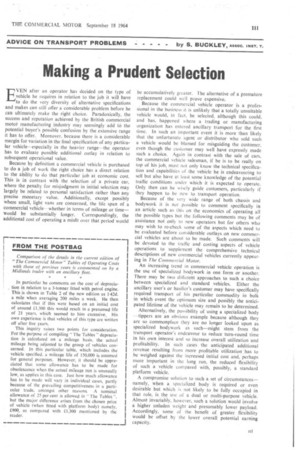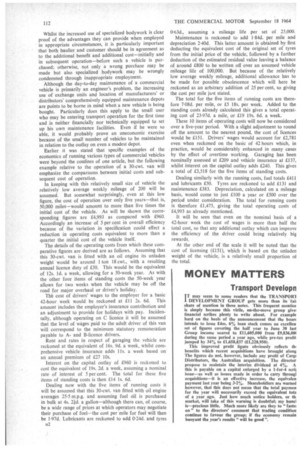Making a Prudent Selection
Page 113

Page 114

If you've noticed an error in this article please click here to report it so we can fix it.
EVEN after an operator has decided on the type of vehicle he requires in relation to the job it will have to do the very diversity of alternative specifications and makes can still offer a considerable problem before he can ultimately make the right choice. Paradoxically, the success and reputation achieved by the British commercial motor manufacturing industry may seemingly add to the potential buyer's possible confusion by the extensive range it has to offer. Moreover, because there is a considerable margin for variation in the final specification of any particular vehicle—especially in the heavier range—the operator has to evaluate possible additional outlay in relation to subsequent operational value.
Because by definition a commercial vehicle is purchased to do a job of work the right choice has a direct relation to the ability to do that particular job at economic cost. This is in contrast with the selection of a private car, where the penalty for misjudgment in initial selection may largely be related to personal satisfaction rather than any precise monetary value. Additionally, except possibly where small, light vans are concerned, the life span of a commercial vehicle—whether in terms of mileage or time— would be substantially longer. • Correspondingly, the additional cost of operating a misfit over that period would
be accumulatively greater. The alternative of a premature replacement could well prove expensive.
Because the commercial vehicle operator is a professional in the business it is unlikely that a totally unsuitable vehicle would, in fact, be selected, although this could, and has, happened where a trading or manufacturing organization has entered ancillary transport for the first time. In such an important event it is more than likely that the unfortunate agent or distributor who sold such a vehicle would be blamed for misguiding the customer, even though the customer may well have expressly made such a choice. Again in contrast with the sale of cars, the commercial vehicle salesman, if he is to be really on top of his job, must not only know the technical specification and capabilities of the vehicle he is endeavouring to sell but also have at least some knowledge of the Potential traffic conditions under which it is expected to operate. Only then can he wisely guide customers, particularly if they happen to be new to transport operation.
Because of the very wide range of both chassis and bodywork it is not possible to comment specifically in an article such as this on the economics of operating all the possible types but the following comments may be of assistance not only to new operators but for others who may wish to re-check some of the aspects which need to be evaluated before considerable outlays on new commercial vehicles are about to be made. Such comments Will be devoted to the traffic and costing aspects of vehicle operations to supplement the comprehensive technical descriptions of new commercial vehicles currently appearing in The Commercial Motor.
An increasing trend in commercial vehicle operation is the use of specialized bodywork in one form or another. There may be two different approaches to such a choice between specialized and standard vehicles. Either the ancillary user's or haulier's customer may have specifically required transport of his particular commodity in bulk in which event the optimum size and possibly the anticipated lifetime of the vehicle may remain to be determined.
Alternatively, the possibility of using a specialized body --tippers are an obvious example because although they are so commonplace they are no longer looked upon as specialized bodywork as such—might stem from the transport operator's endeavour to reduce turn-round time in his own interest and so increase overall utilization and profitability. In such cases the anticipated additional revenue resulting from more profitable utilizationlhas to be weighed against the increased initial cost and, perhaps more important in the long run, the reduced flexibility of such a vehicle compared with, possibly, a standard platform vehicle.
A compromise solution to such a set of circumstances— namely, when a specialized body is required or even desirable but which is not likely to be fully occupied in that role, is the use of a dual or multi-purpose vehicle. Almost invariably, however, such a solution would involve a higher unladen weight and presumably lower payload. Accordingly, some of the benefit of greater flexibility Would be offset by the lower overall potential earning capacity. Whilst the increased use of specialized bodywork is clear proof of the advantages they can provide when employed in appropriate circumstances, it is particularly important that both haulier and customer should be in agreement as to the additional benefit and additional cost—initially and in subsequent operation—before such a vehicle is purchased; otherwise, not only a wrong purchase may be made but also specialized bodywork may be wrongly condemned through inappropriate employment.
Although the day-to-day maintenance of a commercial vehicle is primarily an engineer's problem, the increasing use of exchange units and location of manufacturers' or distributors' comprehensively equipped maintenance depots are points to be borne in mind when a new vehicle is being bought. Particularly does this apply to the small user who may be entering transport operation for the first time and is neither financially nor technically equipped to set up his own maintenance facilities. Even if he were so able, it would probably prove an uneconomic exercise because of the small number of vehicles to be maintained in relation to the outlay on even a modest depot.
Earlier it was stated that specific examples of the economics of running various types of commercial vehicles were beyond the confines of one article, but the following example relative to the operation of a 30-cwt. van will emphasize the comparisons between initial costs and subsequent cost of operation. In keeping with this relatively small size of vehicle the relatively low average weekly mileage of 200 will be assumed. But somewhat surprisingly, even at this low figure, the cost of operation over only five years—that is, 50,000 miles—would amount to more than five times the initial cost of the vehicle. As will be shown the corresponding figures are £4,993 as compared with £960. Accordingly an increase of 5 per cent in overall efficiency because of the variation in specification could effect a reduction in operating costs equivalent to more than a quarter the initial cost of the vehicle itself.
The details of the operating costs from which these comparative figures are derived are as follows. Assuming that this 30-cwt. van is fitted with an oil engine its unladen weight would be around 1 ton 18 cwt., with a resulting annual licence duty of £30. This would be the equivalent of 12s. id. a week, allowing for a 50-week year. As with the other four items of standing costs the 50-week year allows for two weeks when the vehicle may be off the road for major overhaul or driver's holiday.
Th6 cost of drivers' wages to the employer for a basic 42-hour week would be reckoned at £11 2s. 6d. This amount includes the employer's insurance contribution and an adjustment to provide for holidays with pay. Incidentally, although operating on C licence it will be assumed that the level of wages paid to the adult driver of this van will correspond to the minimum statutory remuneration payable to Aand B-licence drivers.
Rent and rates in respect of garaging the vehicle are reckoned at the equivalent of 16s. 9d. a week, whilst comprehensive vehicle insurance adds 1 Is. a week based on an annual premium of £27 10s.
Interest on the capital outlay of £960 is reckoned to cost the equivalent of 19s. 2d. a week, assuming a nominal rate of interest of 5 per cent. The total for these five items of standing costs is then £14 Is. 6d.
Dealing now with the five items of running costs it will be assumed that this 30-cwt. van fitted with oil engine averages 25.5 m.p.g. and assuming fuel dil is purchased in bulk at 4s. 2id. a gallon—although there can, of course, be a wide range of prices at which operators may negotiate their purchase of fuel—the cost per mile for fuel will then be 1-97d. Lubricants are reckoned to add 0.24d. and tyres 142 0.63d., assuming a mileage life per set of 25,000.
Maintenance is reckoned to add 1.84d. per mile and depreciation 2-40d, This latter amount is obtained by first deducting the equivalent cost of the original set of tyres from the initial price of the vehicle, followed by a further deduction of the estimated residual value leaving a balance of around £800 to be written off over an assumed vehicle mileage life of 100,000. But because of the relatively low average weekly mileage, additional allowance has to be made for possible obsolescence which will here be reckoned as an arbitrary addition of 25 per cent, so giving the cost per mile just stated.
The total for the five items of running costs are therefore 7.08d. per mile, or £5 18s. per week. Added to the standing costs already calculated this gives a total operating cost of 23.97d. a mile, or £19 19s. 6d. a week.
These 10 items of operating costs will now be considered over a five-year period. With a slight adjustment to round off the amount to the nearest pound, the cost of licences would be £151. Drivers' wages would account for £2,781 even when reckoned on the basic of 42 hours which, in practice, would be considerably enhanced in many cases by the effect of overtime working. Garaging has been nominally assessed at £209 and vehicle insurance at £137, whilst interest on the capital outlay adds £240. This gives a total of £3,518 for the five items of standing costs.
Dealing similarly with the running costs, fuel totals £411 and lubricants £50. Tyres are reckoned to add £131 and maintenance £383. Depreciation, calculated on a mileage basis, would come to just £100 a year or £500 over the period under consideration. The total for running costs is therefore £1,475, giving the total operating costs of '£4,993 as already mentioned.
It will be seen that even on the nominal basis of a 42-hour week the cost of wages is more than half the total cost, so that any additional outlay which can improve the efficiency of the driver could bring relatively big rewards.
At the other end of the scale it will be noted that the cost of licensing (£151), which is based on the unladen weight of the vehicle, is a relatively small proportion oi the total.


































































































































































































































































